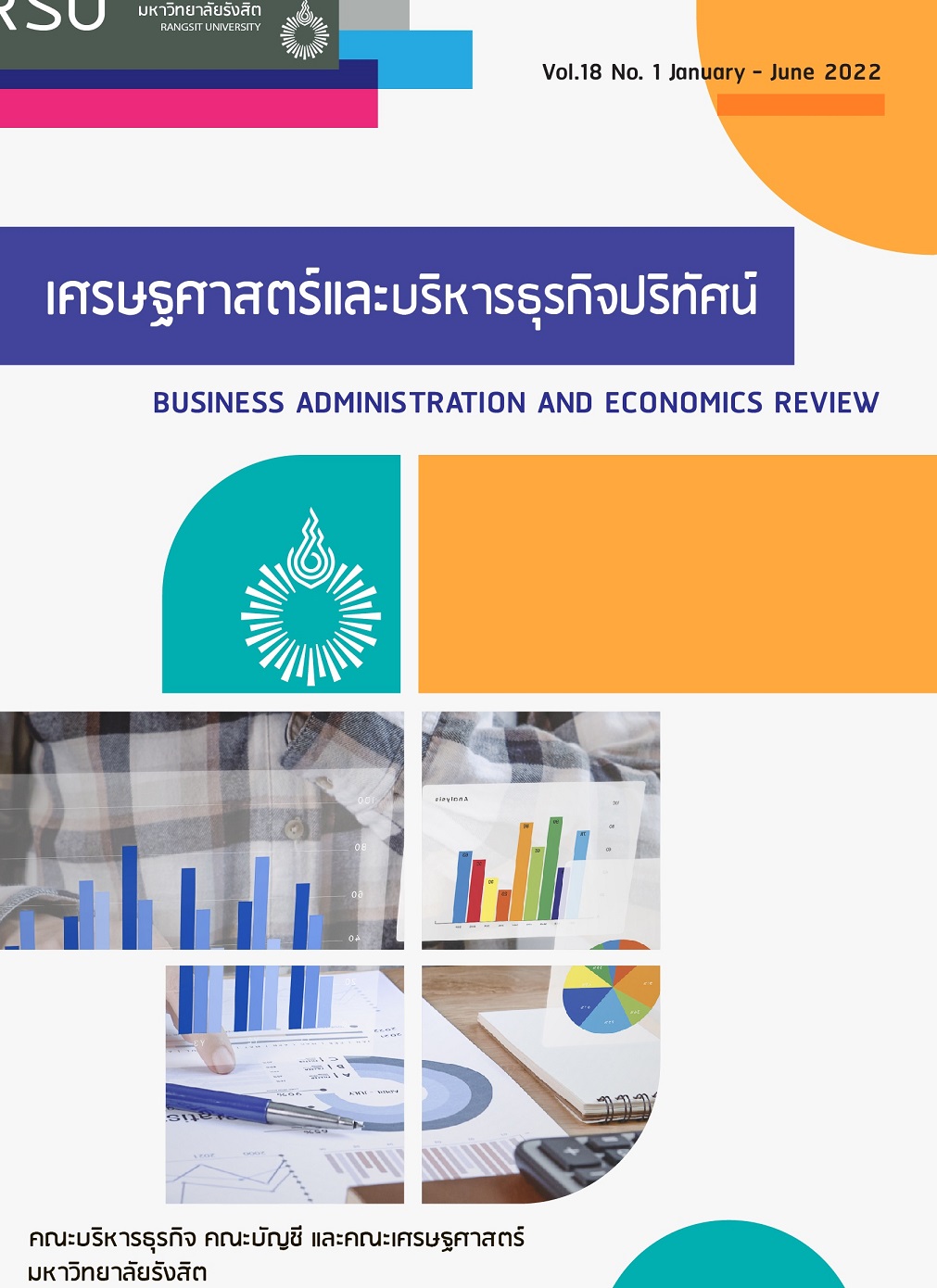Workplace Social Support Factors Affecting Work-Life Balance of Employees of Petrochemical Plants in ABC Public Company Limited Group
Keywords:
work-life balance, workload, role conflict, flexible work arrangement, Job autonomy, co-worker support, supervisor supportAbstract
The purposes of this study were: 1) to study the level of workplace social support factors of the employees in petrochemical plants in ABC public company limited group 2) to examine the influence of workplace social support factors affecting work-life balance of employees in petrochemical plants in ABC public company limited group. The questionnaires were given to 386 employees in petrochemical plants in ABC public company limited group who are working in the units under the operation lines in Rayong province. The implemented statistical methods were descriptive statistics and inferential statistics including multiple linear regressions.The findings indicated that co-workers support and job autonomy affect work-life balance of employees in all 3 components, time balance, involvement balance and satisfaction balance. Supervisor support affect work-life balance in 2 components, time balance and satisfaction balance while workload and role conflict affect work-life balance of employees in negative way only for time balance but no affects to involvement balance and satisfaction balance.
References
ABAC POLL. (2013). Community Happiness Observation and Research.Retrieved from https://www.ryt9.com, 15 March 2019.
Al-Saidi, R.M. (2015). The Impact of Advanced Technology on Work-Life Balance for the Administrative Staff at UNRWA-Gaza Field Office. MBA, The Islamic University.
Babajide, A. (2019). The Impact of Flexible Working Hours on Employees ’s Work-Life Balance in Banking Industry (Case Study of Selected Bank in Osun State). Master of Science Thesis in Industrial Relation and Personnel Management, Osun State University.
Cigna. (2019). 2019 Cigna 360 Well-Being Survey.
Fenlason, K.J. and Beehr, T.A. (1994). Social support and occupational stress: Effects of talking to others. Journal of Organizational Behavior ,15, 157-175.
Fletcher, B.C. & Payne, R.L. (1980). Stress at work: A review and theoretical framework. Personnel Review ,9, 19-29.
Greenhaus, J. H., Collins, K. M., and Shaw, J. D. (2003). The relation between work–family balance and quality of life. Journal of vocational behavior ,63 (3), 510-531.
Johnson, J.V., and Hall, E.M. (1988). Job strain, work place social support and cardiovascular disease: A cross-sectional study of a random sample of the Swedish working population. American Journal of Public Health ,78, 1336-1342.
Kopp, L.R. (2013). The Effects of Perceived Supervisor Work-Life Support on Employee Work-
Life Balance, Job Satisfaction, Organizational Commitment, and Organizational
Citizenship Behavior. Master of Science in Applied Psychology Degree, University of
Wisconsin-Stout.
Lau, R.S.M. (2000). Quality of work life and performance – An ad hoc investigation of two key elements in the service profit chain model. International Journal of Service Industry Management, 11(5), 422-437.
Lehmann, L. (2012). Autonomy and work-life balance and their effects on job satisfaction. MSc Social and Organizational Psychology, Faculty of Social and Behavioral Sciences University of Utrecht.
Morgeson, F. P. and Humphrey, S. E. (2006). The Work Design Questionnaire (WDQ): Developing and validating a comprehensive measure for assessing job design and the nature of work. Journal of Applied Psychology ,91, 1321-1339.
Office of Industrial Economics. (2018). Annual report 2018.
Oludayo, O.A., Salau, O.P., Falola, H.O., Atolagbe, T. M., Ogueyungbo, A., and Fatogun, T.O. (2019). Flexible Work Arrangement Initiatives and Commitment Outcome of Selected Technology-based Banks.
International Journal of Mechanical Engineering and Technology (IJMET),10(3), 161–171.
Omar, M. K., Mohd, I. H. and Ariffin, M. S. (2015). Workload, Role Conflict and Work-life Balance among Employees of an Enforcement Agency in Malaysia. International Journal of Business, Economics and Law, 8(2), 52-57.
Rhoades, L. and Eisenberger, R. (2002). Perceived organizational support: A review of the literature.
Journal of Applied Psychology, 87, 698-714.
Shahid, S. A. et al. (2016). Social Support, Negative Affectivity, and Work Personal Life Balance of Academics. International Journal of Social Science and Humanity, 6(7), 500-504.
Skinner, N. (2005). Workplace Support, Workforce Development TIPS (Theory Into Practice Strategies): A Resource Kit for the Alcohol and Other Drugs Field. National Centre for Education and Training on Addiction (NCETA). Adelaide. Flinders University.
Smith, C. A., Organ, D. W., Near, J. P. (1983). Organizational citizenship behavior: Its nature and antecedents. Journal of Applied Psychology, 68, 653–663.
Suhaimi, S. A., Mohamad, M., Seman, K., Nazmi, M. H., Ismail, N. F. H., Rahman, N. I. A. K., Nee, T. Y. and Jafri, W. N. N. W. (2017). The Effect of Workload and Role Conflict Towards Work-life Balance. The European Proceedings of Social & Behavioral Sciences, 493-500.
Thos. (2019). IWG survey reveals flexible working is the answer for the modern workforce. Retrieved from www.mmthailand.com., 15 April 2020.
Walia, P. (2014). Work-life Balance in Relation to Task Variety and Task Autonomy : A Study of Bank Employees. Journal of Strategic Human Resource Management, 3 (1), 11-15.
Walton, R. E. (1973). Quality of Working Life: What Is It?. Sloan Management Review, 15 (1), 11-21.
Wisassinthu, T. and Rojniruttikul, N. (2017). Factors affecting work-life balance of part-time
employees: A case study of fast food company in Bangkok. Journal of Liberal
Arts and Management Science Kasetsart University, 4(6), 21-32.
Wong, P. Y., Bandar, N. F. A. and Saili, J. (2017). Workplace Factors and Work-life Balance among Employees in selected Services Sector. International Journal of Business and Society, 18(4), 677-684.
Yooprot, T. (2013). Effect of Work Values on Organizational Citizenship Behavior among the
Generations. Business Administration Journal, 36(138), 40-62.
Downloads
Published
How to Cite
Issue
Section
License
Copyright (c) 2022 Business Administration and Economics Review

This work is licensed under a Creative Commons Attribution-NonCommercial-NoDerivatives 4.0 International License.
The contents in Business Administration and Economics Review can be used for publication. But do not modify, modify or use it for trade and profit.


